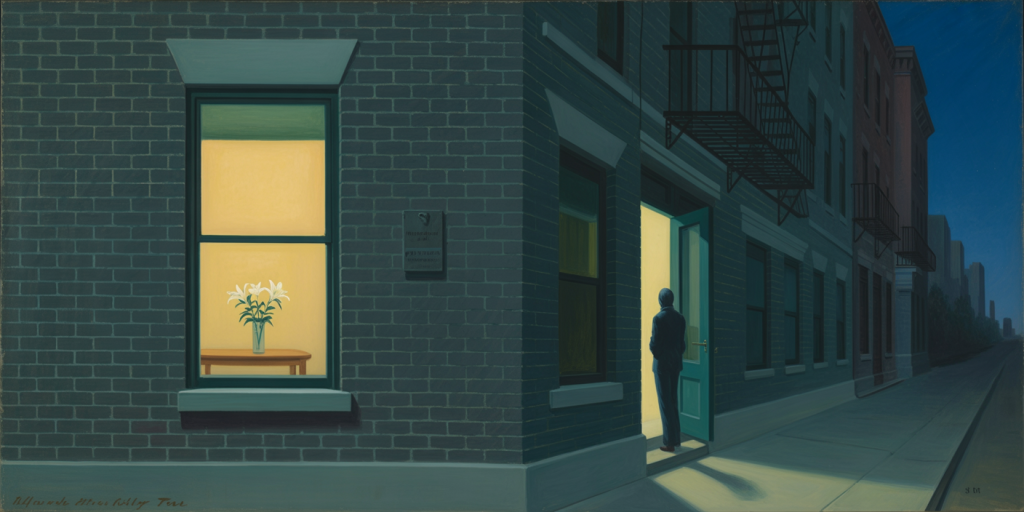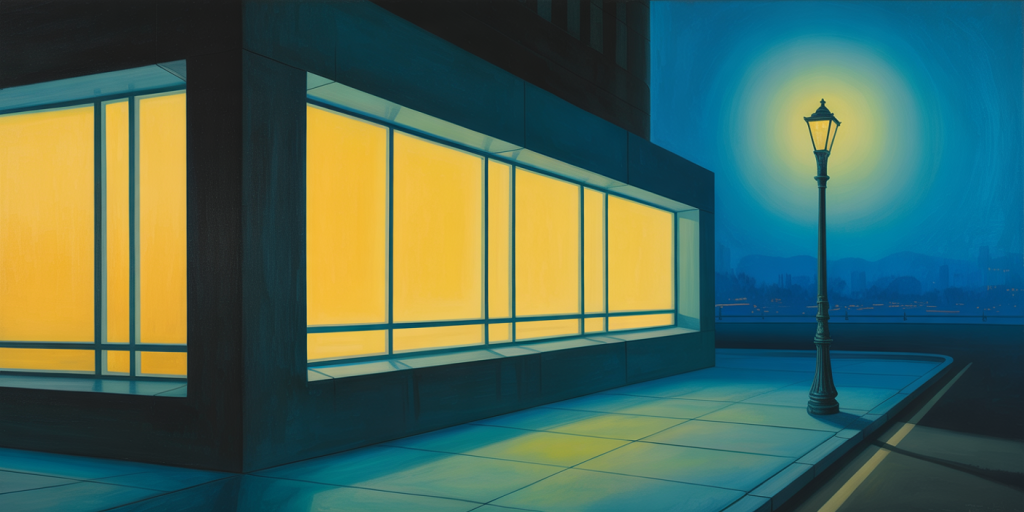Lit Window, Absent World by Edward Hopper
Contemplative Opening
A single lit window in the deep silence of night is not merely a room—it is a confession. It glows like a suspended thought, a tremor of longing flickering within the hush of sleeping walls. Edward Hopper, with his sparse brush and unyielding stillness, painted these moments not to explain them, but to let them breathe.
In Hopper’s universe, the world vanishes but presence sharpens. A window alight becomes a heartbeat. A hush becomes a hymn. His paintings do not tell stories; they wait for them. And in that pause—between one breath and the next—the absent world murmurs its quiet poem.
Table of Contents
- The Pulse Behind the Pane
- Solitude in Broad Brushstrokes
- The Color of Stillness
- Where Light Becomes Flesh
- Composition as Quiet Tension
- The Architecture of Emptiness
- Human Figures as Echoes
- The Silent Clock of Interiors
- Warm Light, Cold Air
- Psychological Distance
- Shadows with Memory
- Urban Geography of Isolation
- The Suspended Gaze
- Flatness That Breathes
- Paint as Whisper
- Narrative Without Movement
- The Metaphysics of the Window
- Furniture and Emotional Weight
- Rooms That Don’t End
- Final Gestures in the Frame
The Pulse Behind the Pane
A lit window beats like a heart inside a concrete body. In Hopper’s paintings, such windows are never fully seen—they are glimpsed. Their glow spills softly into the street, hinting at a life inside but refusing to reveal it.
This pulse is more than visual—it’s emotional. We sense the presence inside even when no figure appears. The window pulses with the rhythm of breath withheld.
Solitude in Broad Brushstrokes
Hopper’s brush is not fussy. It is deliberate. His solitude isn’t sad—it’s structural. He builds loneliness with wide planes and unmixed color, offering no distractions, no embellishments. Only space.
Each stroke carries weight. Not of decoration, but of silence. A silence that isn’t empty, but resonant.
The Color of Stillness
His palette is sparse, almost reluctant. Ochres, muted blues, dusty greens—colors chosen not to dazzle but to murmur. Even red, when it appears, is tired. This stillness of hue creates a sense of breath held too long.
Color in Hopper doesn’t decorate—it defines emotional temperature. A green becomes a sigh. A yellow, a flicker of defiance.
Where Light Becomes Flesh
Hopper’s mastery of light is not about realism. It is about tactility. Light in his world feels like touch. It lands on a woman’s thigh, a wall, a chair—and suddenly, the room has skin.
This sensual luminosity transforms the mundane into the intimate. The light doesn’t just reveal—it caresses.

Composition as Quiet Tension
There’s geometry in Hopper’s loneliness. Walls cut scenes like blades. Windows align with ruthless precision. His composition creates tension—not through chaos, but through control. Too aligned, too clean, too still.
This perfection unnerves. It cages emotion within architecture. The more orderly the space, the louder the silence.
The Architecture of Emptiness
Emptiness in Hopper is never void. It is built. His rooms are not empty because no one’s home—they are empty because something left. Something emotional. His empty spaces are charged. You feel what’s missing.
He teaches us: space does not need to be filled to be full.
Human Figures as Echoes
The people in Hopper’s world are not subjects. They are echoes. Often turned away, gazing elsewhere, half-lit. They are not captured in action, but in waiting. They embody stillness so completely that they become atmosphere.
Their isolation is internal, not circumstantial. Even when two people share a room, they remain worlds apart.
The Silent Clock of Interiors
Time in Hopper does not tick—it drips. There are no clocks, but time is everywhere. In the slant of shadow. In the stretch of a yawn. In the softness of sunlight crawling up a floorboard.
His rooms seem paused mid-breath, holding something fragile that might shatter with movement.
Warm Light, Cold Air
One of Hopper’s most tactile effects is the contrast between warm interior light and cold exterior air. You can feel the difference with your skin. It’s not just visual—it’s somatic.
This duality reflects the emotional distance too: the warmth we seek and the chill we live in.
Psychological Distance
Hopper’s real subject is not space—it’s distance. Emotional, psychological, existential. People are separated from each other by more than walls. They are separated by silence, by hesitation, by their own inner dialogues.
He doesn’t dramatize it. He lets it sit. In the gap between figures. In the blank stare toward a window. In the way no one ever turns to speak.
Shadows with Memory
Shadows in Hopper are not cast by light—they are cast by memory. A shadow on a wall might feel like a past presence. A diagonal shade across a floor feels like a moment that just left.
His shadows don’t obscure. They carry meaning. They hold things the painting refuses to say aloud.
Urban Geography of Isolation
The city in Hopper’s work isn’t busy. It’s bare. It’s a geography of solitude—where buildings rise like monuments to personal silence. Streets are empty not of people, but of purpose.
The city is not hostile. It’s indifferent. Which, perhaps, hurts more.

The Suspended Gaze
Looking in Hopper is an act suspended. No one ever seems fully engaged with what they’re looking at. Their gaze drifts. Rests. Questions. The viewer becomes implicated—we finish the stare. We ask: what are they thinking? What did they just see?
The gaze is always a threshold—between presence and absence.
Flatness That Breathes
Hopper’s canvases have an intentional flatness. It feels theatrical, like a stage. But within that flatness, something breathes. The static becomes dynamic through emotional pressure. Stillness has weight. Flatness has pulse.
It’s like holding your breath during a pause in a song.
Paint as Whisper
His brushstrokes do not shout. They whisper. They drag quietly across canvas. No flourish. No spectacle. The painting arrives like a memory—dim, detailed, deliberate.
This whispering technique reinforces the mood. There is no need to explain. The silence speaks for itself.
Narrative Without Movement
There’s story in every frame—but it hasn’t started yet. Or it’s already passed. Hopper captures the space between. The room after a fight. The chair before a letter is opened. The window where something once was.
He teaches us that narrative exists even in pause. Especially in pause.
The Metaphysics of the Window
The window is Hopper’s altar. A place of longing. A symbol of boundary. It divides not only inside from outside, but self from world. To look out is to yearn. To be looked at is to ache.
Each window is a philosophical question: what lies beyond, and why can’t I reach it?
Furniture and Emotional Weight
Even the objects in Hopper carry emotion. A chair is never just wood—it is a waiting body. A table is not a surface—it is absence settled into form. The room arranges itself like a psychological map.
Inanimate things in his paintings throb with lived emotion.
Rooms That Don’t End
Hopper frames only part of the room. A corner. A doorway. A window. What lies beyond is unknown—and that’s the point. The space expands in our mind. The story spills past the edge.
His composition leaves us wondering: what’s beyond that frame? What silence is just out of view?

Final Gestures in the Frame
Every Hopper painting ends not with a statement—but with a gesture. A turn of the head. A slant of light. A half-opened blind. These gestures do not resolve—they leave us suspended.
They ask nothing more of us than attention. Quiet, honest attention.
FAQ – Frequently Asked Questions
Who was Edward Hopper?
An American realist painter known for his depictions of urban and rural solitude, characterized by stark lighting, architectural framing, and emotional stillness.
Why is the window a recurring motif in his work?
The window serves as a metaphor for psychological separation, longing, and observation—an interface between self and world.
What is unique about Hopper’s use of light?
His light doesn’t merely illuminate—it sculpts emotion. It defines mood, time of day, and unspoken narrative.
Is Hopper’s work sad?
Not exactly. It is quiet. It deals with solitude, but not despair. There is often a dignity in the stillness he portrays.
Why do his paintings feel cinematic?
Because of their composition, framing, and suspended narrative. They resemble film stills—frozen just before or after something meaningful.
Final Reflections – Stillness that Breathes
In Hopper’s universe, stillness is not stagnation—it is breath held. Each lit window a slow exhale into the night. His paintings do not resolve—they linger. They hover. They hum in the quiet.
To witness a Hopper window is to be reminded of our own interiors. To see that silence glows. That absence, sometimes, is the truest presence of all.
